-
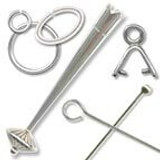 More Sterling Silver Findings
More Sterling Silver Findings
-
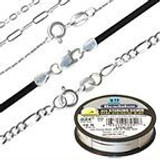 Sterling Chokers, Chain & Beading Cable
Sterling Chokers, Chain & Beading Cable
-
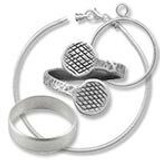 Sterling Rings & Bracelets
Sterling Rings & Bracelets
-
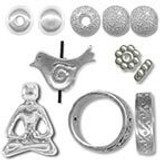 Sterling Silver Beads & Bead Caps
Sterling Silver Beads & Bead Caps
-
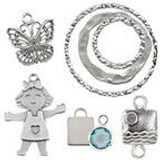 Sterling Silver Charms & Links
Sterling Silver Charms & Links
-
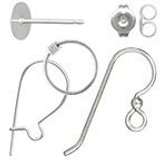 Sterling Silver Earring Findings
Sterling Silver Earring Findings
Sterling Silver: Defining Quality
- Sterling silver is defined as a metal alloy (blend) containing at least 92.5% silver. The most common sterling alloy is 92.5% silver and 7.5% copper.
- Tarnish-resistant Argentium silver findings and wire are 93.5% - 94% silver, and the remaining 6 - 6.5% is a combination of copper and germanium. This patented silver alloy is tarnish-resistant, with the tarnish resistance actually increasing over time! Germanium atoms in the alloy migrate to the surface, allowing the protective germanium oxide layer to regenerate. Argentium silver doesn't develop firescale, which makes its production cleaner for the environment.
- Fine silver, sometimes stamped ".999", is 99.9% pure silver, which means it is softer and more malleable than sterling. Fine silver can be fused! (Sterling silver requires solder; fine silver can be joined with just heat, no solder required.)
Sterling components and jewelry made in the USA are often stamped "sterling." Goods made for international trade are often marked "925" indicating the 92.5% fineness. "Coin" silver is used in some countries and could be marked "900" or "800" depending on fineness.
Other possible markings are less clear. "Mexican Silver," "German Silver," "Indian Silver," "Montana Silver" and simply "silver" do not guarantee any silver content. "German Silver," "Alpacca," and "Alpaca" are merely other names for the alloy of copper, nickel and zinc usually called "nickel silver." Despite the name, nickel silver contains no silver.
In many countries, precious metal must be stamped with a quality mark such as "925" for sterling. Some countries require jewelry made of precious metal be submitted to a governmental assay office for destructive testing before being marked and sold.
Sterling Silver is very easy to test. Silver-plated brass, nickel silver or low quality silver alloys will turn green when a drop of nitric acid is applied, because of the high copper content. Sterling will turn a creamy color. When testing suspect goods, a small file can be used to cut through any plating or lacquer in a discreet area on the item.
In the USA, The National Gold and Silver Marketing Act does not require precious metals to be marked with quality. However, if a quality mark is used, the mark must be accompanied by a manufacturer's hallmark that is a registered trademark or the name of the manufacturer. If there is ever a question about the content of a piece of jewelry, the manufacturer can be traced using the hallmark stamped on the piece. This accountability is particularly important in gold jewelry. A devious manufacturer could mark a piece 18kt when, in fact, it was 10kt and worth one-third less on gold content alone.
For many reasons, not all silver jewelry is marked. For one thing, registering a trademark costs over $1,000. Makers may choose to not spend so much money for a formal hallmark. Small-time artists and Native American silversmiths rarely trademark their work. Furthermore, the sizes or designs of some pieces do not lend themselves to quality markings. Findings and components, for example are often not quality stamped. Users of finished jewelry, however, can choose to attach a mark to the finished piece (for example on a chain tab). Update: US law now does allow the maker's name in place of a formally registered trademark or hallmark! This satisfies the accountability at the heart of the US stamping act.
In summary
- Sterling silver must be at least 92.5% silver.
- US law does not require precious metal to be marked with a quality stamp.
- Some European countries do require marking. Many tourists in the US (and international online shoppers) will question goods sold without markings that indicate precious-metal quality.
- US law requires a maker's mark in the form of a hallmark or registered trademark in addition to the quality mark if the goods are quality marked. The name of the artist or manufacturer may now be used for this.
Main Sources of Information on Sterling Silver
- Federal Trade Commission, National Gold and Silver Marketing Act
- US House of Representatives document 15 USC 297
- Jeweler's Vigilance Committee
- Manufacturing Jewelers and Silversmiths of America
- Jewelry: Concepts and Technology, reference book by Oppi Untracht
- Product
- Qty in Cart
- Quantity
- Price
- Subtotal
-


Sterling Silver 4mm Round Bead, Silicone-Lined (Each)
$0.86Green Silver All our sterling silver items are nickel free. And this sterling silver item is even better! This item is made from environmentally responsible green silver. See Related Products links (below) for similar items and additional... -


Sterling Silver Square Charm with Water and Sky (Each)
$2.79All of our sterling silver is nickel-free, cadmium free and meets the EU Nickel Directive. See Related Products links (below) for similar items, additional jewelry-making supplies that are often used with this item, and general information about these... -


Sterling Silver Earring Back, Medium Weight Butterfly Nut (12 Pieces)
$3.55See Related Products links (below) to see all styles of earring backs on one page -- plus, the main Earring Backs category includes tips on picking the best style of earring backs for your projects, and how to adjust poorly fitting earring nuts. Green... -
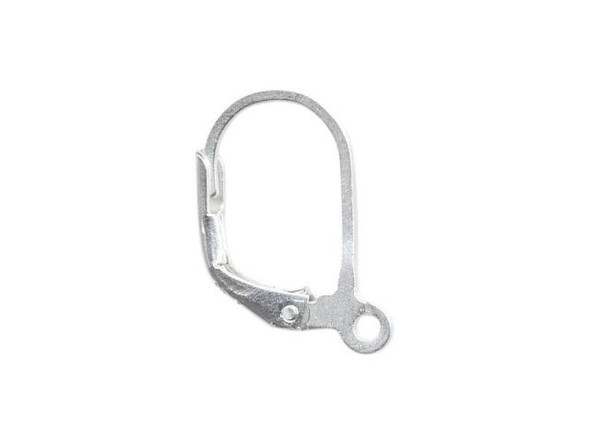
Sterling Silver Leverback Ear Wire, Plain (1 pair)
$4.94All of our sterling silver is nickel-free, cadmium free and meets the EU Nickel Directive. See Related Products links (below) for similar items, additional jewelry-making supplies that are often used with this item, and general information about these... -

Sterling Silver Ear Thread, 5", 2.5mm Closed Jump Ring (pair)
$4.46A quick way to make linear earrings! Attach dangles, thread beads on, or leave plain. Use post to penetrate piercing, then pull through. Available in Sterling Silver and Vermeil. Select styles available in both original... -


Sterling Silver French Hook Earring Wires, Economy (12 Pieces)
$6.79All of our sterling silver is nickel-free, cadmium free and meets the EU Nickel Directive. See Related Products links (below) for similar items, additional jewelry-making supplies that are often used with this item, and general information about these... -


Sterling Silver Lobster Clasp, 10mm (Each)
$1.27All of our sterling silver is nickel-free, cadmium free and meets the EU Nickel Directive. See Related Products links (below) for similar items, additional jewelry-making supplies that are often used with this item, and general information about these... -


Sterling Silver French Hook Earring Wires, 14mm Straight Leg (12 Pieces)
$5.59All of our sterling silver is nickel-free, cadmium free and meets the EU Nickel Directive. See Related Products links (below) for similar items, additional jewelry-making supplies that are often used with this item, and general information about these... -


Sterling Silver Oval Knot Charm, Cast, 9x21mm (Each)
$6.39All of our sterling silver is nickel-free, cadmium free and meets the EU Nickel Directive. See Related Products links (below) for similar items, additional jewelry-making supplies that are often used with this item, and general information about these... -


Sterling Silver Earring Backs, Butterfly Nut - Lightweight (12 Pieces)
$2.09All of our sterling silver is nickel-free, cadmium free and meets the EU Nickel Directive. See Related Products links (below) to see all styles of earring backs on one page -- plus, the main Earring Backs category includes tips on picking the best... -


Sterling Silver Ear Thread, 4", Wavy Bars (pair)
$5.31A quick way to make linear earrings! Attach dangles, thread beads on, or leave plain. Use post to penetrate piercing, then pull through. Available in Sterling Silver and Vermeil. Select styles available in both original... -


Sterling Silver Jewelry Connector, Swirl, 4 Loop (Each)
$3.07All of our sterling silver is nickel-free, cadmium free and meets the EU Nickel Directive. See Related Products links (below) for similar items, additional jewelry-making supplies that are often used with this item, and general information about these... -

Sterling Silver Bezel Cup, Round, 10mm, 1 Loop (Each)
$3.37Which Glue is Best? For the most durable bond, we almost always recommend epoxies rather than other types of glue, but it depends on a few factors... Check out the options, plus tips for successful glue bonds, on our Adhesives and Jewelry Glues page. See... -


Sterling Silver Jump Ring, Round - 3mm, 24-gauge (10 Pieces)
$0.66HINT When you open and close jump rings, twist ends instead of "ovaling" them. This keeps their round shape better, which makes them easier to close securely. Green Silver All our sterling silver items are nickel free. And this... -


Sterling Silver Spiral Charm (Each)
$4.05All of our sterling silver is nickel-free, cadmium free and meets the EU Nickel Directive. See Related Products links (below) for similar items, additional jewelry-making supplies that are often used with this item, and general information about these... -


Sterling Silver Beads, Round, 2mm (100 Pieces)
$4.35Green Silver All our sterling silver items are nickel free. And this sterling silver item is even better! This item is made from environmentally responsible green silver. See Related Products links (below) for similar items and additional... -


Sterling Silver Jump Ring, Round - 4mm, 19.5-gauge (10 Pieces)
$2.29HINT When you open and close jump rings, twist ends instead of "ovaling" them. This keeps their round shape better, which makes them easier to close securely. Green Silver All our sterling silver items are nickel free. And this... -


Sterling Silver Jewelry Link, Heart, 15mm (Each)
$1.39All of our sterling silver is nickel-free, cadmium free and meets the EU Nickel Directive. See Related Products links (below) for similar items, additional jewelry-making supplies that are often used with this item, and general information about these... -


Sterling Silver Plain Wire Stacking Ring, Size 5 (Each)
$2.29Green Silver All our sterling silver items are nickel free. And this sterling silver item is even better! This item is made from environmentally responsible green silver. See Related Products links (below) for similar items and additional... -


Sterling Silver Jump Ring, Round - 4mm, 22-gauge (10 Pieces)
$1.29HINT When you open and close jump rings, twist ends instead of "ovaling" them. This keeps their round shape better, which makes them easier to close securely. Green Silver All our sterling silver items are nickel free. And this... -


Sterling Silver Flower Charm, 11x17x2mm (Each)
$3.75All of our sterling silver is nickel-free, cadmium free and meets the EU Nickel Directive. See Related Products links (below) for similar items, additional jewelry-making supplies that are often used with this item, and general information about these... -

JBB Findings Sterling Silver Center-Crimp Tube with Loop, 3.5mm I.D. (Each)
JBB$1.831. You'll need: Crimp ends, cording, round-nose pliers, and (optional) some glue. 2. Add a dab of glue to the cording; slide the crimp-end over the cording. 3. Firmly grip the pliers to flatten the center section of the crimp. See... -


Sterling Silver Magnetic Jewelry Clasp, Superior Quality, Button, 4.5mm (Each)
$2.69Green Silver All our sterling silver items are nickel free. And this sterling silver item is even better! This item is made from environmentally responsible green silver. See Related Products links (below) for similar items and additional... -


Sterling Silver Spring Ring Clasp, 5mm (10 Pieces)
$1.90All of our sterling silver is nickel-free, cadmium free and meets the EU Nickel Directive. See Related Products links (below) for similar items, additional jewelry-making supplies that are often used with this item, and general information about these... -


TierraCast Sterling Silver Angular French Hook with Bead (pair)
TierraCast$3.09All of our sterling silver is nickel-free, cadmium free and meets the EU Nickel Directive. See Related Products links (below) for similar items, additional jewelry-making supplies that are often used with this item, and general information about these... -

JBB Findings Sterling Silver Charm, Jewelry Connector, Small (Each)
JBB$0.54All of our sterling silver is nickel-free, cadmium free and meets the EU Nickel Directive. See Related Products links (below) for similar items, additional jewelry-making supplies that are often used with this item, and general information about these... -


Sterling Silver Butterfly Charm, 11x10x2mm (Each)
$2.59All of our sterling silver is nickel-free, cadmium free and meets the EU Nickel Directive. See Related Products links (below) for similar items, additional jewelry-making supplies that are often used with this item, and general information about these... -


Sterling Silver Lily of the Valley Swirl Jewelry Connector, 2 Loop (Each)
$11.15All of our sterling silver is nickel-free, cadmium free and meets the EU Nickel Directive. See Related Products links (below) for similar items, additional jewelry-making supplies that are often used with this item, and general information about these... -


Sterling Silver Jump Ring, Round - 4mm, 20.5-gauge (10 Pieces)
$1.79HINT When you open and close jump rings, twist ends instead of "ovaling" them. This keeps their round shape better, which makes them easier to close securely. Green Silver All our sterling silver items are nickel free. And this... -


Sterling Silver Jewelry Link, Round, 14mm (Each)
$1.48All of our sterling silver is nickel-free, cadmium free and meets the EU Nickel Directive. See Related Products links (below) for similar items, additional jewelry-making supplies that are often used with this item, and general information about these... -


Sterling Silver Tiny Key Charm (Each)
$0.98All of our sterling silver is nickel-free, cadmium free and meets the EU Nickel Directive. See Related Products links (below) for similar items, additional jewelry-making supplies that are often used with this item, and general information about these... -

Sterling Silver Bezel Cup, Round, 10mm, 2 Loop (Each)
$3.95All of our sterling silver is nickel-free, cadmium free and meets the EU Nickel Directive. See Related Products links (below) for similar items, additional jewelry-making supplies that are often used with this item, and general information about these... -


Sterling Silver Textured Artsy Heart Charm (Each)
$1.29All of our sterling silver is nickel-free, cadmium free and meets the EU Nickel Directive. See Related Products links (below) for similar items, additional jewelry-making supplies that are often used with this item, and general information about these... -


Sterling Silver Jewelry Link, Round, 20mm (Each)
$2.03All of our sterling silver is nickel-free, cadmium free and meets the EU Nickel Directive. See Related Products links (below) for similar items, additional jewelry-making supplies that are often used with this item, and general information about these... -

Sterling Silver Cable Chain Necklace, 18", Medium, 2.0mm (Each)
$4.68All of our sterling silver is nickel-free, cadmium free and meets the EU Nickel Directive. See Related Products links (below) for similar items, additional jewelry-making supplies that are often used with this item, and general information about these... -


TierraCast Sterling Silver French Hook, Hoop Style - Plain (pair)
TierraCast$3.65All of our sterling silver is nickel-free, cadmium free and meets the EU Nickel Directive. See Related Products links (below) for similar items, additional jewelry-making supplies that are often used with this item, and general information about these... -


Sterling Silver Jump Ring, Round - 5mm, 18-gauge (10 Pieces)
$3.65HINT When you open and close jump rings, twist ends instead of "ovaling" them. This keeps their round shape better, which makes them easier to close securely. Green Silver All our sterling silver items are nickel free. And this... -


Sterling Silver Jump Ring, Round - 5mm, 20.5-gauge (10 Pieces)
$2.29HINT When you open and close jump rings, twist ends instead of "ovaling" them. This keeps their round shape better, which makes them easier to close securely. Green Silver All our sterling silver items are nickel free. And this... -


Sterling Silver Split Rings, 6mm (10 Pieces)
$3.11All of our sterling silver is nickel-free, cadmium free and meets the EU Nickel Directive. See Related Products links (below) for similar items, additional jewelry-making supplies that are often used with this item, and general information about these... -


Sterling Silver Tiny Hammered Heart Charm (Each)
$1.79Sterling Silver: Sterling silver, sometimes stamped .925 or simply 925, is an alloy of at least 92.5% silver. The remaining 7.5% is usually copper. All of our sterling silver is nickel-free, cadmium-free, lead-free, and meets the EU Nickel Directive... -
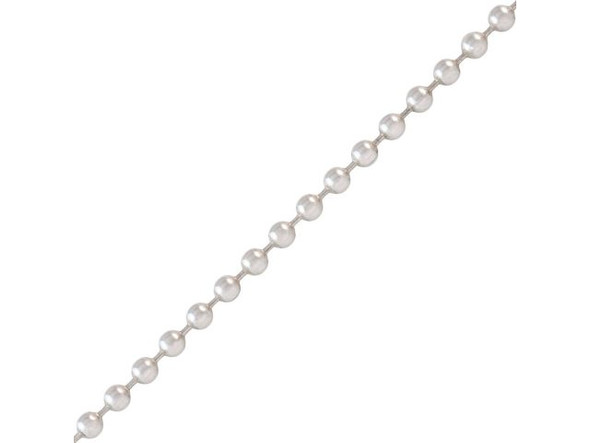
Sterling Silver Ball Chain, 2.4mm by the FOOT
$10.59Use with #40-501 Ball Chain Clasp (in the Ball Chain Accessories category). All of our sterling silver is nickel-free, cadmium free and meets the EU Nickel Directive. See Related Products links (below) for similar items, additional jewelry-making... -

Sterling Silver Clamp, Necklace, 12mm (Each)
$5.89All of our sterling silver is nickel-free, cadmium free and meets the EU Nickel Directive. See Related Products links (below) for similar items, additional jewelry-making supplies that are often used with this item, and general information about these... -


Sterling Silver Tiny Crescent Moon Bead (Each)
$3.17Sterling Silver: Sterling silver, sometimes stamped .925 or simply 925, is an alloy of at least 92.5% silver. The remaining 7.5% is usually copper. All of our sterling silver is nickel-free, cadmium-free, lead-free, and meets the EU Nickel Directive... -


Sterling Silver Tiny Skeleton Key Charm (Each)
$2.29All of our sterling silver is nickel-free, cadmium free and meets the EU Nickel Directive. See Related Products links (below) for similar items, additional jewelry-making supplies that are often used with this item, and general information about these... -


MAG-LOK Sterling Silver Magnetic Jewelry Clasp, Superior Quality, 7mm (Each)
MAG-LOK$4.89So easy to use, you might want to convert all your jewelry to magnetic clasps! Always open jewelry by holding the clasp directly, instead of tugging the cord. For extra security, we recommend tying cord directly to the clasp or using split... -

Sterling Silver Finger Ring Blank, Adjustable, Plain (Each)
$11.55Which Glue is Best? For the most durable bond, we almost always recommend epoxies rather than other types of glue, but it depends on a few factors... Check out the options, plus tips for successful glue bonds, on our Adhesives and Jewelry Glues page. See... -

Sterling Silver Kidney Ear Wire, Round Bezel, 10mm, 1-Loop (pair)
$9.45All of our sterling silver is nickel-free, cadmium free and meets the EU Nickel Directive. See Related Products links (below) for similar items, additional jewelry-making supplies that are often used with this item, and general information about these... -


Sterling Silver Plain Wire Stacking Ring, Size 6 (Each)
$2.39Green Silver All our sterling silver items are nickel free. And this sterling silver item is even better! This item is made from environmentally responsible green silver. See Related Products links (below) for similar items and additional... -

Sterling Silver Bezel Cup, Oval, 12x10mm, 1 Loop (Each)
$3.47All of our sterling silver is nickel-free, cadmium free and meets the EU Nickel Directive. See Related Products links (below) for similar items, additional jewelry-making supplies that are often used with this item, and general information about these... -

Sterling Silver Bezel Cup, Oval, 20x15mm, 1 Loop (Each)
$5.89All of our sterling silver is nickel-free, cadmium free and meets the EU Nickel Directive. See Related Products links (below) for similar items, additional jewelry-making supplies that are often used with this item, and general information about these... -


MAG-LOK Sterling Silver Magnetic Jewelry Clasp, Superior Quality, Button, 8mm (Each)
MAG-LOK$7.34So easy to use, you might want to convert all your jewelry to magnetic clasps! Always open jewelry by holding the clasp directly, instead of tugging the cord. For extra security, we recommend tying cord directly to the clasp or using split... -

Sterling Silver Jewelry Clasp, Hook & Eye (Each)
$5.59All of our sterling silver is nickel-free, cadmium free and meets the EU Nickel Directive. See Related Products links (below) for similar items, additional jewelry-making supplies that are often used with this item, and general information about these... -

Sterling Silver Jump Ring, Round - 5mm, 19.5-gauge (10 Pieces)
$2.97HINT When you open and close jump rings, twist ends instead of "ovaling" them. This keeps their round shape better, which makes them easier to close securely. Green Silver All our sterling silver items are nickel free. And this... -


Sterling Silver Pansy Charm (Each)
$2.49All of our sterling silver is nickel-free, cadmium free and meets the EU Nickel Directive. See Related Products links (below) for similar items, additional jewelry-making supplies that are often used with this item, and general information about these... -

JBB Findings Sterling Silver Center-Crimp Tube with Loop, 4mm I.D. (Each)
JBB$1.931. You'll need: Crimp ends, cording, round-nose pliers, and (optional) some glue. 2. Add a dab of glue to the cording; slide the crimp-end over the cording. 3. Firmly grip the pliers to flatten the center section of the crimp. See... -


JBB Findings Sterling Silver Finger Ring Blank, Adjustable, Double Pad (Each)
JBB$10.91Which Glue is Best? For the most durable bond, we almost always recommend epoxies rather than other types of glue, but it depends on a few factors... Check out the options, plus tips for successful glue bonds, on our Adhesives and Jewelry Glues page. See... -


Sterling Silver Heart Charm #44-046-53
$3.07All of our sterling silver is nickel-free, cadmium free and meets the EU Nickel Directive. See Related Products links (below) for similar items, additional jewelry-making supplies that are often used with this item, and general information about these... -

JBB Findings Sterling Silver Necklace End, 2 Strand (Each)
JBB$1.80All of our sterling silver is nickel-free, cadmium free and meets the EU Nickel Directive. See Related Products links (below) for similar items, additional jewelry-making supplies that are often used with this item, and general information about these... -


Sterling Silver Snowflake Charm, 19x13x1mm (Each)
$3.85Matching snowflake connector also available! All of our sterling silver is nickel-free, cadmium free and meets the EU Nickel Directive. See Related Products links (below) for similar items, additional jewelry-making supplies that are often used with... -


Sterling Silver 7mm Flower Charm (Each)
$2.29All of our sterling silver is nickel-free, cadmium free and meets the EU Nickel Directive. See Related Products links (below) for similar items, additional jewelry-making supplies that are often used with this item, and general information about these... -

Sterling Silver Bead, Curved Tube, 52mm (Each)
$2.91All of our sterling silver is nickel-free, cadmium free and meets the EU Nickel Directive. See Related Products links (below) for similar items, additional jewelry-making supplies that are often used with this item, and general information about these... -

Sterling Silver Plain Wire Stacking Ring, Size 7 (Each)
$2.49Green Silver All our sterling silver items are nickel free. And this sterling silver item is even better! This item is made from environmentally responsible green silver. See Related Products links (below) for similar items and additional... -

Sterling Silver Bezel Cup, Round, 15mm, 1 Loop (Each)
$5.59Which Glue is Best? For the most durable bond, we almost always recommend epoxies rather than other types of glue, but it depends on a few factors... Check out the options, plus tips for successful glue bonds, on our Adhesives and Jewelry Glues page. See... -
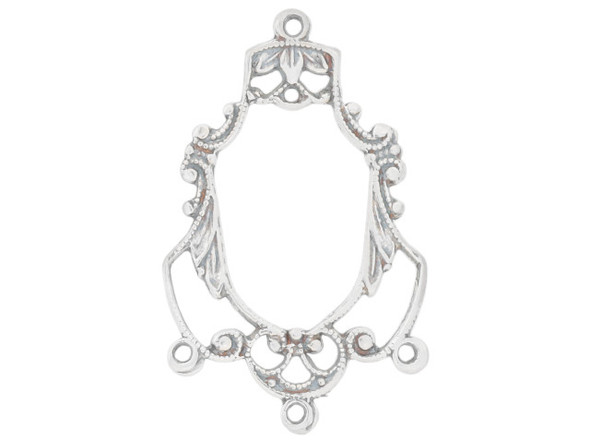

Sterling Silver Filigree, Victorian (Each)
$4.67All of our sterling silver is nickel-free, cadmium free and meets the EU Nickel Directive. See Related Products links (below) for similar items, additional jewelry-making supplies that are often used with this item, and general information about these... -

Sterling Silver Bail, Tube Top, 14mm (Each)
$6.39Which Glue is Best? For the most durable bond, we almost always recommend epoxies rather than other types of glue, but it depends on a few factors... Check out the options, plus tips for successful glue bonds, on our Adhesives and Jewelry Glues page. See... -

Sterling Silver Bezel Cup, Round, 25mm, 1 Loop (Each)
$8.27All of our sterling silver is nickel-free, cadmium free and meets the EU Nickel Directive. See Related Products links (below) for similar items, additional jewelry-making supplies that are often used with this item, and general information about these... -


Sterling Silver Awareness Ribbon Charm, 15x9.5x1mm (Each)
$2.48All of our sterling silver is nickel-free, cadmium free and meets the EU Nickel Directive. See Related Products links (below) for similar items, additional jewelry-making supplies that are often used with this item, and general information about these... -


Sterling Silver Hammered-End "Endless" Hoop Style Earwire, 25mm (1 pair)
$2.11Green Silver All our sterling silver items are nickel free. And this sterling silver item is even better! This item is made from environmentally responsible green silver. See Related Products links (below) for similar items and additional... -


Sterling Silver Bead Cap With Peg, Medium (Each)
$1.69Designed with a peg to fit half-drilled beads. We recommend using a 2-part epoxy or Loctite gel super glue. All of our sterling silver is nickel-free, cadmium free and meets the EU Nickel Directive. See Related Products links (below) for similar... -

Sterling Silver Beads, Round, 4mm (10 Pieces)
$3.24Green Silver All our sterling silver items are nickel free. And this sterling silver item is even better! This item is made from environmentally responsible green silver. See Related Products links (below) for similar items and additional... -


Sterling Silver Twisty Bar Jewelry Connector, 2 Loop (Each)
$3.27All of our sterling silver is nickel-free, cadmium free and meets the EU Nickel Directive. See Related Products links (below) for similar items, additional jewelry-making supplies that are often used with this item, and general information about these... -

Sterling Silver Clasp, Double Push Lobster, 12mm (Each)
$1.44All of our sterling silver is nickel-free, cadmium free and meets the EU Nickel Directive. See Related Products links (below) for similar items, additional jewelry-making supplies that are often used with this item, and general information about these... -


Sterling Silver Disk Charm, 9.3mm (Each)
$3.65Sterling Silver: Sterling silver, sometimes stamped .925 or simply 925, is an alloy of at least 92.5% silver. The remaining 7.5% is usually copper. All of our sterling silver is nickel-free, cadmium-free, lead-free, and meets the EU Nickel Directive... -

Sterling Silver Ear Thread, 3", 3mm Ball (pair)
$3.55A quick way to make linear earrings! Attach dangles, thread beads on, or leave plain. Use post to penetrate piercing, then pull through. Available in Sterling Silver and Vermeil. Select styles available in both original... -


Sterling Silver 11mm Jewelry Connector, Hammered Disk, 2 Hole (Each)
$4.05All of our sterling silver is nickel-free, cadmium free and meets the EU Nickel Directive. See Related Products links (below) for similar items, additional jewelry-making supplies that are often used with this item, and general information about these... -

Sterling Silver Ball End Endless Hoop Style Earwire, 18mm (pair)
$1.40Green Silver All our sterling silver items are nickel free. And this sterling silver item is even better! This item is made from environmentally responsible green silver. See Related Products links (below) for similar items and additional... -


Sterling Silver Bead, Keishi-Style, Center-Drilled, 10mm (Each)
$3.47All of our sterling silver is nickel-free, cadmium free and meets the EU Nickel Directive. See Related Products links (below) for similar items, additional jewelry-making supplies that are often used with this item, and general information about these... -


MAG-LOK Sterling Silver Magnetic Jewelry Clasp, Superior Quality, Button, 6mm (Each)
MAG-LOK$2.91So easy to use, you might want to convert all your jewelry to magnetic clasps! Always open jewelry by holding the clasp directly, instead of tugging the cord. For extra security, we recommend tying cord directly to the clasp or using split... -


Sterling Silver Crimp Tube, 2x2mm, "Size 2" (80 pieces)
$7.07Discover the elegance and durability of our sterling silver 2x2mm crimp tubes, perfect for every jewelry artisan. Whether you're creating a timeless bracelet, a delicate necklace, or a chic pair of earrings, these crimp tubes are your go-to for ensuring... -


Sterling Silver Jump Ring, Round, Soldered - 6mm, 20.5-gauge (10 Pieces)
$3.45Green Silver All our sterling silver items are nickel free. And this sterling silver item is even better! This item is made from environmentally responsible green silver. See Related Products links (below) for similar items and additional... -


Sterling Silver Kidney Ear Wire, 35mm (12 Pieces)
$15.85HINT After attaching your drop, use round nose pliers to crimp the loop closed. This keeps your drop in place. Green Silver All our sterling silver items are nickel free. And this sterling silver item is even better! This item is made from... -

Sterling Silver Bead, Angel Wing, 28mm (Each)
$8.47All of our sterling silver is nickel-free, cadmium free and meets the EU Nickel Directive. See Related Products links (below) for similar items, additional jewelry-making supplies that are often used with this item, and general information about these... -

Sterling Silver Glue-On Jewelry Bail, Oval, Medium (Each)
$6.69Which Glue is Best? For the most durable bond, we almost always recommend epoxies rather than other types of glue, but it depends on a few factors... Check out the options, plus tips for successful glue bonds, on our Adhesives and Jewelry Glues page. See... -


JBB Findings Sterling Silver Briolette Cap, Scalloped (Each)
JBB$2.06All of our sterling silver is nickel-free, cadmium free and meets the EU Nickel Directive. See Related Products links (below) for similar items, additional jewelry-making supplies that are often used with this item, and general information about these... -

Sterling Silver Bead Grommet, 4mm (10 Pieces)
$2.30Green Silver All our sterling silver items are nickel free. And this sterling silver item is even better! This item is made from environmentally responsible green silver. See Related Products links (below) for similar items and additional... -

Sterling Silver Jewelry Clasp, Infinity, 7x11mm (Each)
$4.34All of our sterling silver is nickel-free, cadmium free and meets the EU Nickel Directive. See Related Products links (below) for similar items, additional jewelry-making supplies that are often used with this item, and general information about these... -

Sterling Silver 1.1mm Fine Rope Chain Spool, Footage (foot)
$5.94Fine cable chain like this is commonly used as beading chain. Because it is so fine, only very thin jump rings fit through the end link. More durable alternatives for finishing the ends: Solder a heavier jump ring to the end, or use a center-crimp or a... -


Sterling Silver Crimp Cover, 4mm (10 Pieces)
$4.77For a fast, professional finish, conceal flattened crimps and scratchy wire cable ends with a crimp cover! You'll get a great looking bead every time and can focus on making crimps that hold instead of just crimps that look nice. Crescent shape... -

Sterling Silver Glue-On Jewelry Bail, Round, 7mm (Each)
$2.19All of our sterling silver is nickel-free, cadmium free and meets the EU Nickel Directive. See Related Products links (below) for similar items, additional jewelry-making supplies that are often used with this item, and general information about these... -

JBB Findings Sterling Silver Center-Crimp Tube with Loop, 2.5mm I.D. (Each)
JBB$1.581. You'll need: Crimp ends, cording, round-nose pliers, and (optional) some glue. 2. Add a dab of glue to the cording; slide the crimp-end over the cording. 3. Firmly grip the pliers to flatten the center section of the crimp. See... -

JBB Findings Sterling Silver Tube-Style Bail (Each)
JBB$2.12All of our sterling silver is nickel-free, cadmium free and meets the EU Nickel Directive. See Related Products links (below) for similar items, additional jewelry-making supplies that are often used with this item, and general information about these... -

Sterling Silver Heart Post Earring with Loop (1 Pair)
$7.87All of our sterling silver is nickel-free, cadmium free and meets the EU Nickel Directive. See Related Products links (below) for similar items, additional jewelry-making supplies that are often used with this item, and general information about these... -


Sterling Silver Square Connector with Spiral Heart - 2 Loops (Each)
$6.19All of our sterling silver is nickel-free, cadmium free and meets the EU Nickel Directive. See Related Products links (below) for similar items, additional jewelry-making supplies that are often used with this item, and general information about these... -


JBB Findings Sterling Silver Pinch Bail, Prong Bail, Ornate (Each)
JBB$1.46All of our sterling silver is nickel-free, cadmium free and meets the EU Nickel Directive. See Related Products links (below) for similar items, additional jewelry-making supplies that are often used with this item, and general information about these... -

Sterling Silver Finger Ring Blank, Adjustable, Wavy (Each)
$14.25Which Glue is Best? For the most durable bond, we almost always recommend epoxies rather than other types of glue, but it depends on a few factors... Check out the options, plus tips for successful glue bonds, on our Adhesives and Jewelry Glues page. See... -


Sterling Silver Jump Ring, Round, Soldered - 5mm, 22-gauge (10 Pieces)
$2.49Green Silver All our sterling silver items are nickel free. And this sterling silver item is even better! This item is made from environmentally responsible green silver. See Related Products links (below) for similar items and additional... -

Sterling Silver Ear Thread, 3", 3.5mm Open Jump Ring (pair)
$3.32A quick way to make linear earrings! Attach dangles, thread beads on, or leave plain. Use post to penetrate piercing, then pull through. Available in Sterling Silver and Vermeil. Select styles available in both original... -

Sterling Silver Plain Wire Stacking Ring, Size 9 (Each)
$2.38Green Silver All our sterling silver items are nickel free. And this sterling silver item is even better! This item is made from environmentally responsible green silver. See Related Products links (below) for similar items and additional... -


Sterling Silver Ear Thread, 3", Box and Cable Chain (pair)
$4.89A quick way to make linear earrings! Attach dangles, thread beads on, or leave plain. Use post to penetrate piercing, then pull through. Available in Sterling Silver and Vermeil. Select styles available in both original... -


Sterling Silver Jewelry Link, Square, 8mm (Each)
$1.32All of our sterling silver is nickel-free, cadmium free and meets the EU Nickel Directive. See Related Products links (below) for similar items, additional jewelry-making supplies that are often used with this item, and general information about these...
